Contamination and Spatial Variation of Heavy Metals in the Soil-Rice System in Nanxun County, Southeastern China
Abstract
:1. Introduction
2. Experimental Section
2.1. Study Area and Sampling Site Description
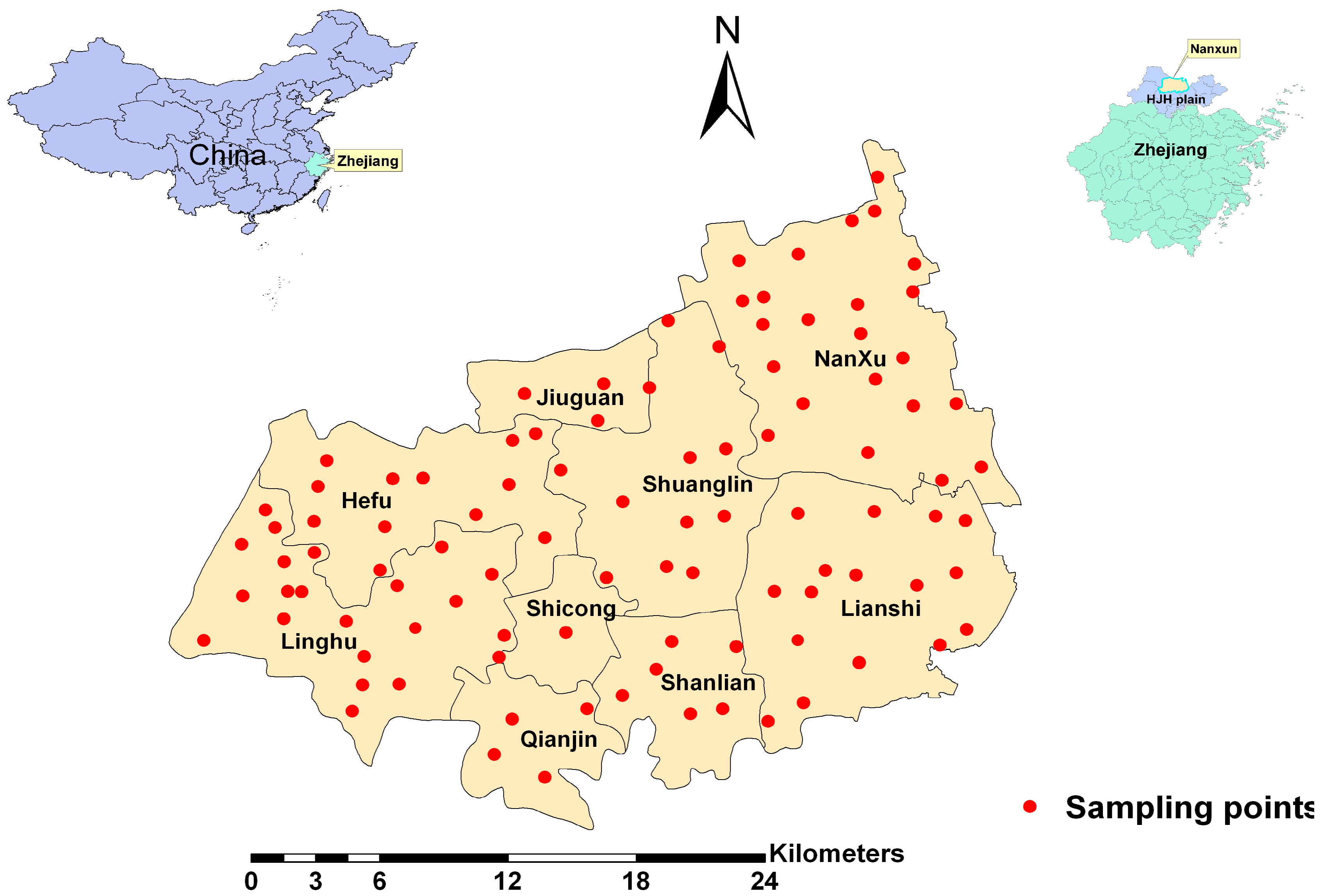
2.2. Laboratory Analyses
2.3. Evaluation Method for Soil Pollution and Standard
| Heavy Metals | Background Values in Zhejiang | The First Level | The Second Level | The Third Level | Food Safety Standards (in Rice) | ||
|---|---|---|---|---|---|---|---|
| pH < 6.5 | pH 6.5–7.5 | pH > 7.5 | pH > 6.5 | ||||
| Cd | 0.129 | 0.2 | 0.3 | 0.3 | 0.6 | 1.0 | 0.2 |
| Cu | 30.54 | 35 | 50 | 100 | 100 | 400 | 10 |
| Ni | 36.48 | 40 | 40 | 50 | 60 | 200 | 10 |
| Pb | 30.46 | 35 | 250 | 300 | 350 | 500 | 0.2 |
| Zn | 107.79 | 100 | 200 | 250 | 300 | 500 | 50 |
2.4. Geostatistical Analysis
2.5. Data Analysis with Computer Software
3. Results
3.1. Heavy Metal Concentrations in the Soil-Rice System
| Metals | Mean | SD | Min | Max | Kurtosis | Skewness | CV (%) |
|---|---|---|---|---|---|---|---|
| Cdsoil | 0.21 | 0.07 | 0.12 | 0.78 | 33.90 (0.32) | 4.66 (0.29) | 34.96 |
| Cusoil | 31.06 | 7.45 | 18.80 | 82.31 | 22.22 (0.82) | 3.50 (0.21) | 23.97 |
| Nisoil | 32.14 | 6.75 | 18.49 | 55.59 | 0.38 | 0.19 | 21.00 |
| Pbsoil | 33.20 | 5.34 | 20.19 | 51.71 | 1.07 | 0.65 | 16.08 |
| Znsoil | 106.82 | 30.05 | 61.55 | 266.93 | 9.30 (0.37) | 2.33 (0.39) | 28.13 |
| Cdrice | 0.011 | 0.015 | 0.003 | 0.103 | 28.13(1.67) | 5.04 (1.07) | 126.88 |
| Curice | 2.49 | 0.74 | 1.06 | 4.23 | −0.13 | 0.22 | 29.62 |
| Nirice | 0.125 | 0.173 | 0.025 | 1.403 | 36.43 (1.47) | 5.66 (0.81) | 138.64 |
| Znrice | 14.28 | 2.70 | 9.45 | 21.97 | −0.21 | 0.59 | 18.93 |
3.2. The Accumulation and Pollution of Heavy Metals in Paddy Fields
| Metals | Background Value as Critical Value | Second Grade Standardized Value as Critical Value | ||||||
|---|---|---|---|---|---|---|---|---|
| Mean | Min | Max | Ratio (%) | Mean | Min | Max | Ratio (%) | |
| Cd | 1.65 | 0.91 | 6.06 | 99.00 | 0.71 | 0.39 | 2.61 | 6.00 |
| Cu | 1.02 | 0.62 | 2.70 | 49.00 | 0.62 | 0.38 | 1.65 | 2.00 |
| Ni | 0.88 | 0.51 | 1.52 | 27.00 | 0.80 | 0.46 | 1.39 | 9.00 |
| Pb | 1.09 | 0.66 | 1.70 | 69.00 | 0.13 | 0.08 | 0.21 | 0 |
| Zn | 0.99 | 0.57 | 2.48 | 40.00 | 0.53 | 0.31 | 1.33 | 2.00 |
| Standard | Clean I * < 0.7 | Precaution Level 0.7 < I < 1 | Light Pollution 1 < I < 2 | Moderate Pollution 2 < I < 3 | Heavy Pollution I > 3 |
|---|---|---|---|---|---|
| Background Value | 0 | 5 | 88 | 6 | 1 |
| Second grade Standardized Value | 43 | 54 | 2 | 1 | 0 |
3.3. Transfer Rate of Heavy Metals from Soil to Rice
3.4. Spatial Structure and Spatial Distribution
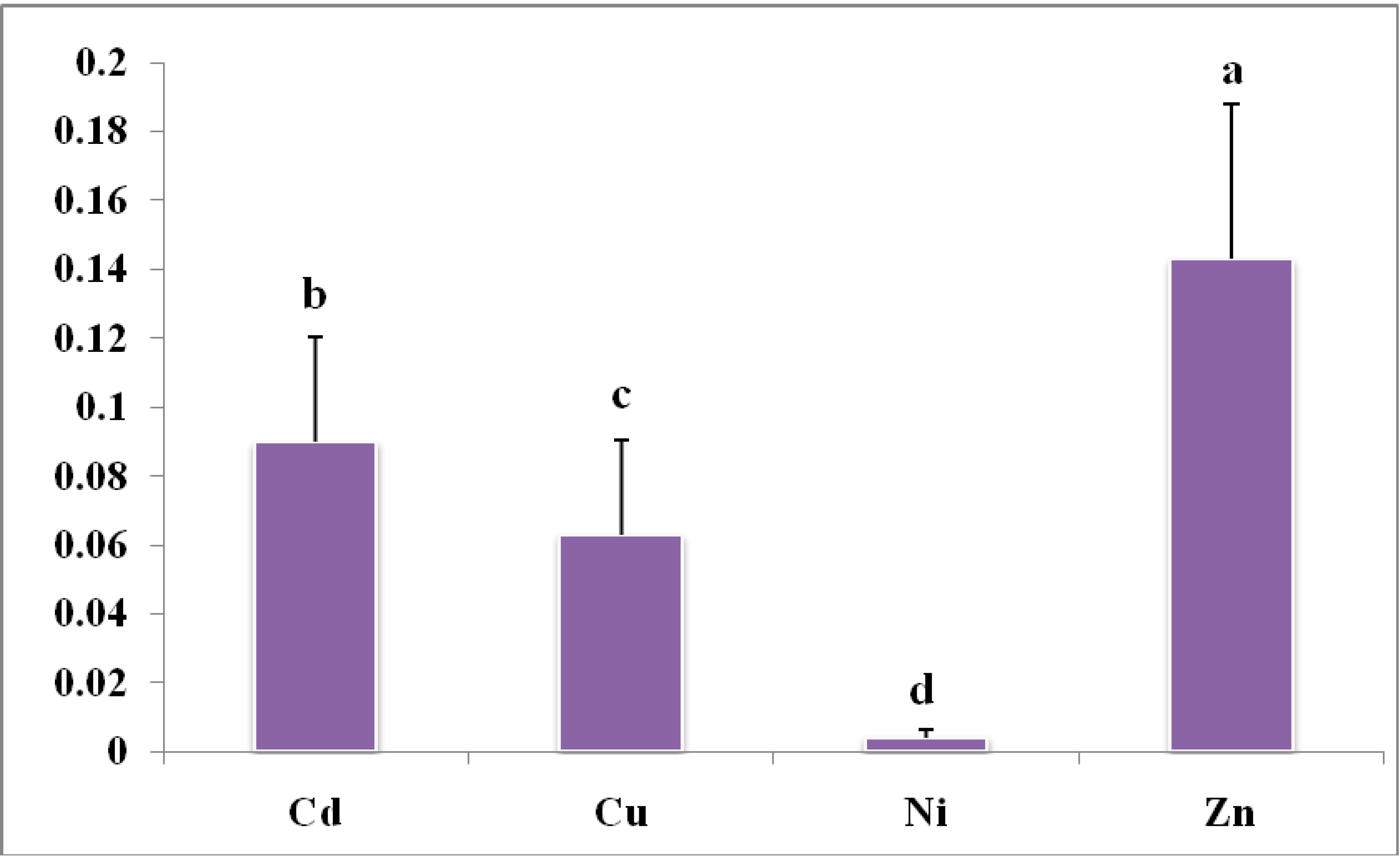
| Metals | Distribution Type | Models | (Nugget) C0 | (Sill) C0 + C | (Nugget/Sill %) C0/(C0 + C) | Range A (km) | R2 |
|---|---|---|---|---|---|---|---|
| Cdsoil | Log-normal | Spherical | 0.011 | 0.043 | 25.6 | 0.80 | 0.986 |
| Cusoil | Log-normal | Exponential | 0.014 | 0.047 | 29.6 | 31.68 | 0.972 |
| Nisoil | Normal | Spherical | 18.50 | 55.82 | 33.1 | 21.07 | 0.960 |
| Pbsoil | Normal | Spherical | 15.91 | 32.55 | 48.9 | 22.43 | 0.876 |
| Znsoil | Log-normal | Exponential | 0.030 | 0.059 | 49.9 | 13.26 | 0.796 |
| Cdrice | Log-normal | Exponential | 0.252 | 0.775 | 33.4 | 21.33 | 0.824 |
| Curice | Normal | Exponential | 0.386 | 0.907 | 42.6 | 12.70 | 0.892 |
| Nirice | Log-normal | Exponential | 0.050 | 0.380 | 13.2 | 3.93 | 0.828 |
| Znrice | Normal | Exponential | 1.06 | 7.31 | 14.5 | 4.59 | 0.913 |
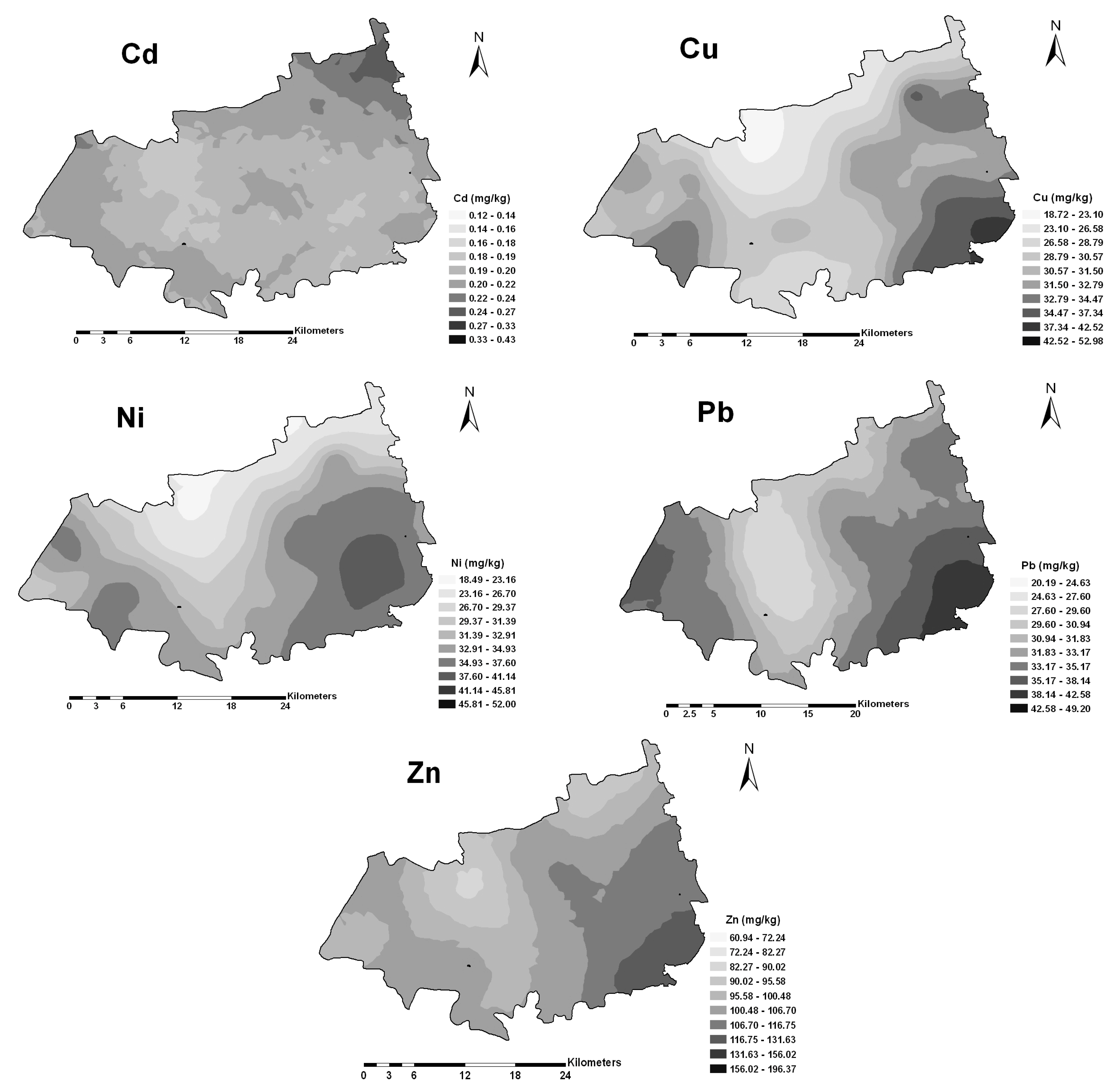
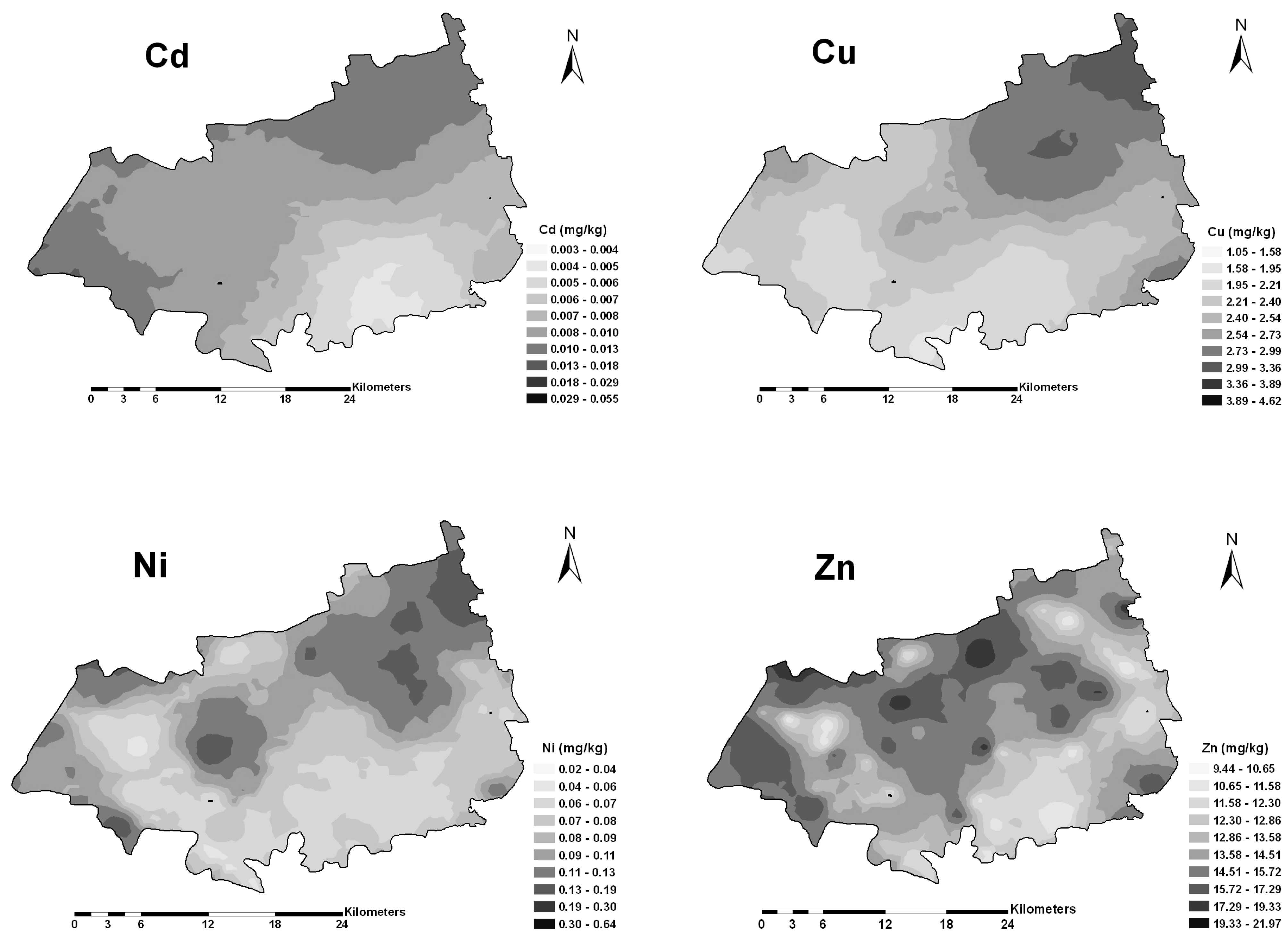

3.5. Spatial Correlation between Heavy Metals in Rice and Soil Properties
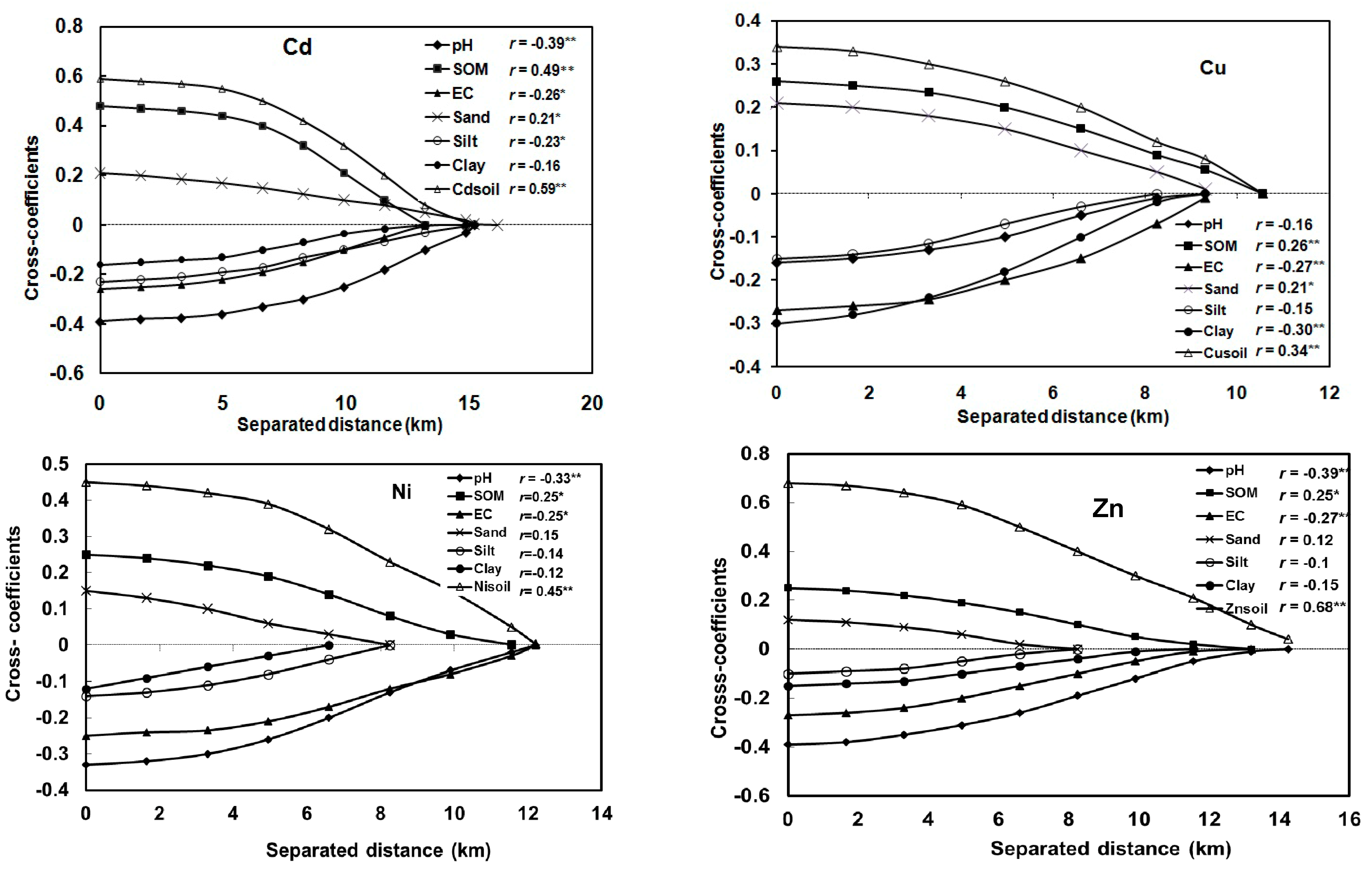
4. Discussion
5. Conclusions
Acknowledgments
Author Contributions
Conflicts of Interest
References
- Wong, S.C.; Li, X.D.; Zhang, G.Q.; Min, Y.S. Heavy metals in agricultural soils of the Pearl River Delta, South China. Environ. Pollut. 2002, 119, 33–44. [Google Scholar] [CrossRef] [PubMed]
- Adriano, D.C. Trace Elements in Terrestrial Environments: Biogeochemistry, Bioavailability, and Risks of Metals; Springer: New York, NY, USA, 2001. [Google Scholar]
- Huang, P.M.; Gobran, G.R. Biogeochemistry of Trace Elements in the Rhizosphere; Elsevier: Amsterdam, The Netherlands, 2005. [Google Scholar]
- Zhao, K.L.; Liu, X.M.; Zhang, W.W.; Xu, J.M.; Wang, F. Spatial dependence and bioavailability of metal fractions in paddy fields on metal concentrations in rice grain at a regional scale. J. Soil Sediment. 2011, 11, 1165–1177. [Google Scholar] [CrossRef]
- Chen, H.M.; Zheng, C.R.; Tu, C.; Zhu, Y.G. Heavy metal pollution in soils in China: Status and countermeasures. AMBIO 1999, 28, 130–134. [Google Scholar]
- Huang, S.S.; Liao, Q.L.; Hua, M.; Wu, X.M.; Bi, K.S.; Yan, C.Y.; Chen, B.; Zhang, X.Y. Survey of heavy metal pollution and assessment of agricultural soil in Yangzhong district, Jiang Su Province, China. Chemosphere 2007, 67, 2148–2155. [Google Scholar] [CrossRef] [PubMed]
- Liu, H.Y.; Probst, A.; Liao, B.H. Metal contamination of soils and crops affected by the Chenzhou lead/zinc mine spill (Hunan, China). Sci. Total. Environ. 2005, 339, 153–166. [Google Scholar] [CrossRef] [PubMed] [Green Version]
- Haldar, M.; Mandal, L.N. Effect of phosphorus and zinc on the growth and phosphorus zinc, copper, iron and manganese nutrition of rice. Plant Soil 1981, 59, 415–425. [Google Scholar] [CrossRef]
- Wang, Q.R.; Cui, Y.S.; Liu, X.M.; Dong, Y.T.; Christie, P. Soil contamination and plant uptake of heavy metals at polluted sites in China. J. Environ. Sci. Health. A. 2003, 38, 823–838. [Google Scholar] [CrossRef]
- Cheng, W.D.; Zhang, G.P.; Yao, H.G.; Dominy, P.; Wu, W.; Wang, R.Y. Possibility of predicting heavy-metal contents in rice grains based on DTPA-extracted levels in soil. Commun. Soil Sci. Plan. 2004, 35, 2731–2745. [Google Scholar] [CrossRef]
- Li, Z.W.; Li, L.; Pan, G.X.; Chen, J. Bioavailability of Cd in a soil-rice system in China: Soil type vs. genotype effects. Plant Soil 2005, 271, 165–173. [Google Scholar] [CrossRef]
- Liu, X.M.; Wu, J.J.; Xu, J.M. Characterizing the risk assessment of heavy metals and sampling uncertainty analysis in paddy field by geostatistics and GIS. Environ. Pollut. 2006, 141, 257–264. [Google Scholar] [CrossRef] [PubMed]
- Zhao, K.L.; Liu, X.M.; Xu, J.M.; Selim, H.M. Heavy metal contaminations in a soil-rice system: Identification of spatial dependence in relation to soil properties of paddy fields. J. Hazard. Mater. 2010, 181, 778–787. [Google Scholar] [CrossRef] [PubMed]
- Agricultural Chemistry Committee of China. Conventional Methods of Soil and Agricultural Chemistry Analysis; Science Press: Beijing, China, 1983. (In Chinese) [Google Scholar]
- China Green Food Development Center. Environmental Quality Assessment for Green Food Production Program; Science Press: Beijing, China, 1994. (In Chinese) [Google Scholar]
- Zhejiang Soil Survey Office. Zhejiang Soils; Zhejiang Technology Press: Hangzhou, China, 1994; pp. 556–562. (In Chinese) [Google Scholar]
- Ministry of Environmental Protection of China. Environmental Quality Standard for Soils; China Environment Press: Beijing, China, 2005. (In Chinese)
- Goovaerts, P. Geostatistics for Natural Resources Evaluation; Oxford University Press: New York, NY, USA, 1997. [Google Scholar]
- Webster, R.; Oliver, M.A. Geostatistics for Environmental Scientists; Wiley: Chichester, UK, 2001. [Google Scholar]
- Stein, M.B.; Walker, J.R.; Hazen, A.L.; Forde, D.R. Full and partial posttraumatic stress disorder: Findings from a community survey. Am. J. Psychiatry 1997, 154, 1114–1119. [Google Scholar] [CrossRef] [PubMed]
- Deutsch, C.V.; Journel, A.G. Geostatistical Software Library and User’s Guide; Oxford University Press: New York, NY, USA, 1998. [Google Scholar]
- Cambardella, C.A.; Moorman, A.T.; Novak, J.M.; Parkin, T.B.; Karlen, D.L.; Turco, R.F.; Konopka, A.E. Field-scale variability of soil properties in central Iowa soils. Soil Sci. Soc. Am. J. 1994, 58, 1501–1511. [Google Scholar] [CrossRef]
- Gao, C.; Zhang, T.L. Environmental management: Options practiced in Europe to mitigate agricultural nutrient pollution of ground and surface water. Rural Eco-Environ. 1999, 15, 50–53. (In Chinese) [Google Scholar]
- Wang, Q.C.; Ma, Z.W. Heavy metals in chemical fertilizer and environmental risks. Rural Eco-Environ. 2004, 20, 62–64. (In Chinese) [Google Scholar]
- Quan, W.M.; Shen, J.F.; Dong, M.Q.; Zhang, Q.L.; Lu, Z.M.; Sheng, B.L. Treatment measures on agricultural non-point pollution in Hang-Jia-Hu Plain. Rural Environ. Devel. 2002, 2, 22–24. (In Chinese) [Google Scholar]
- Plumlee, K.H. Toxicosis from agricultural chemicals. Clin. Tech. Equine. Pract. 2002, 1, 94–97. [Google Scholar] [CrossRef]
- Fu, J.J.; Zhang, A.Q.; Wang, T.; Qu, G.B.; Shao, J.J.; Yuan, B.; Wang, Y.W.; Jiang, G. Influence of E-waste dismantling and its regulations: temporal trend, spatial distribution of heavy metals in rice grains, and its potential health risk. Environ. Sci. Technol. 2013, 47, 7427–7445. [Google Scholar]
- Fu, J.J.; Zhou, Q.F.; Liu, J.M.; Liu, W.; Wang, T.; Zhang, Q.H.; Jiang, G.B. High levels of heavy metals in rice (Oryza sativa L.) from a typical E-waste recycling area in southeast China and its potential risk to human health. Chemosphere 2008, 71, 1269–1275. [Google Scholar] [CrossRef] [PubMed]
- Cui, X.T.; Luan, W.L.; Shi, S.J.; Li, S.M.; Song, Z.F.; Ma, Z.S. Soil heavy metal pollution assessment in the sewage irrigation region of Shijiazhuang city. Earth Environ. 2010, 38, 36–42. (In Chinese) [Google Scholar]
- Kashem, M.A.; Singh, B.R. Metal availability in contaminated soils: II. Uptake of Cd, Ni and Zn in rice plants grown under flooded culture with organic matter addition. Nutr. Cycl. Agroecosys. 2001, 61, 257–266. [Google Scholar] [CrossRef]
- Jung, M.C.; Thornton, I. Environmental contamination and seasonal variation of metals in soils, plants and waters in the paddy fields around a Pb-Zn mine in Korea. Sci. Total Environ. 1997, 198, 105–121. [Google Scholar] [CrossRef] [PubMed]
- Cheng, D.W.; Zhang, G.P.; Yao, H.G.; Wu, W.; Tang, M.L.; Zhu, Z.J.; Xu, M. Genotypic and environmental variation and their stability of As, Cr, Cd, Ni and Pb concentrations in the grains of Japonica Rice. Acta Agromomica Sinca 2006, 32, 572–579. [Google Scholar]
- Zeng, F.R.; Mao, Y.; Cheng, W.D.; Wu, F.B.; Zhang, G.P. Genotypic and environmental variation in chromium, cadmium and lead concentrations in rice. Environ. Pollut. 2008, 153, 309–314. [Google Scholar] [CrossRef] [PubMed]
- Facchinelli, A.; Sacchi, E.; Mallen, L. Multivariate statistical and GIS-based approach to identify heavy metal sources in soil. Environ. Pollut. 2001, 114, 313–324. [Google Scholar] [CrossRef] [PubMed]
- Martín, J.A.R.; Arias, M.L.; Grau Corbí, J.M. Heavy metals contents in agricultural topsoils in the Ebro basin (Spain): Application of the multivariate geostatistical methods to study spatial variations. Environ. Pollut. 2006, 144, 1001–1012. [Google Scholar] [CrossRef] [PubMed]
- Sadeghi, A.; Graff, C.D.; Starr, J.; Mccarty, G.; Codling, E.; Sefton, K. Spatial variability of soil phosphorous levels before and after poultry litter application. Soil. Sci. 2006, 171, 850–857. [Google Scholar] [CrossRef]
- Fu, W.; Zhao, K.; Jiang, P.; Ye, Z.; Tunney, H.; Zhang, C.S. Field-scale variability of soil test phosphorus and other nutrients in grasslands under long-term agricultural managements. Soil Res. 2013, 51, 503–512. [Google Scholar] [CrossRef]
- Chen, T.; Liu, X.M.; Li, X.; Zhao, K.L.; Zhang, J.B.; Xu, J.M.; Shi, J.C.; Dahlgren, R.A. Heavy metal sources identification and sampling uncertainty analysis in a field-scale vegetable soil of Hangzhou, China. Environ. Pollut. 2009, 157, 1003–1010. [Google Scholar] [CrossRef]
- Webster, R.; Oliver, M.A. Statistical Methods in Soil and Land Resource Survey; Oxford University Press: London, UK, 1990. [Google Scholar]
- Burgos, P.; Madejón, E.; Pérez-de-Mora, A.; Cabrera, F. Spatial variability of the chemical characteristics of a trace-element-contaminated soil before and after remediation. Geoderma 2006, 130, 157–175. [Google Scholar] [CrossRef]
- Goodchild, M.F.; Parks, B.O.; Steyaret, L.T. Environmental Modelling with GIS; Oxford University Press: New York, NY, USA, 1993. [Google Scholar]
- Statistical Bureau of Huzhou. Huzhou Yearbook; China Statistics Press: Beijing, China, 2011. (In Chinese) [Google Scholar]
- Wu, C.F.; Luo, Y.M.; Zhang, L.M. Variability of copper availability in paddy fields in relation to selected soil properties in Southeast China. Geoderma 2010, 156, 200–206. [Google Scholar] [CrossRef]
- Ma, L.Q.; Rao, G.N. Chemical fractionation of cadmium, copper, nickel, and zinc in contaminated soils. J. Environ. Qual. 1997, 26, 259–264. [Google Scholar] [CrossRef]
- Basta, N.T.; Ryan, J.A.; Chaney, R.L. Trace element chemistry in residual-treated soil: Key concepts and metal bioavailability. J. Environ. Qual. 2005, 34, 49–63. [Google Scholar] [PubMed]
© 2015 by the authors; licensee MDPI, Basel, Switzerland. This article is an open access article distributed under the terms and conditions of the Creative Commons Attribution license (http://creativecommons.org/licenses/by/4.0/).
Share and Cite
Zhao, K.; Fu, W.; Ye, Z.; Zhang, C. Contamination and Spatial Variation of Heavy Metals in the Soil-Rice System in Nanxun County, Southeastern China. Int. J. Environ. Res. Public Health 2015, 12, 1577-1594. https://doi.org/10.3390/ijerph120201577
Zhao K, Fu W, Ye Z, Zhang C. Contamination and Spatial Variation of Heavy Metals in the Soil-Rice System in Nanxun County, Southeastern China. International Journal of Environmental Research and Public Health. 2015; 12(2):1577-1594. https://doi.org/10.3390/ijerph120201577
Chicago/Turabian StyleZhao, Keli, Weijun Fu, Zhengqian Ye, and Chaosheng Zhang. 2015. "Contamination and Spatial Variation of Heavy Metals in the Soil-Rice System in Nanxun County, Southeastern China" International Journal of Environmental Research and Public Health 12, no. 2: 1577-1594. https://doi.org/10.3390/ijerph120201577






